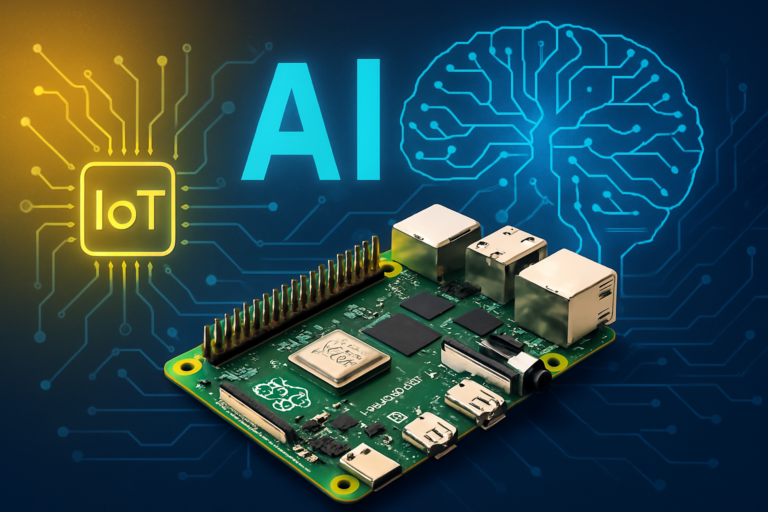In the last few years, the way we live in cities has changed a lot. One of the main reasons behind this change is IoT, or the Internet of Things. This technology connects different devices to the internet so they can talk to each other and share information. This helps cities become smarter, safer, and more efficient.
A smart city uses IoT to improve services like traffic control, waste management, street lighting, public safety, and more. It’s not just about adding technology — it’s about using data to make life easier for everyone.
What Is IoT in Simple Words?
IoT means everyday objects can connect to the internet. These objects can be sensors, machines, vehicles, lights, or even bins. They collect information and send it to a central system. That system can then analyze the data and make smart decisions — often automatically. One of the most popular tools for building small IoT devices is the Raspberry Pi. This tiny computer is cheap, powerful, and easy to program. It’s used by students, developers, and even companies to build smart gadgets and systems.
For example, a smart streetlight with a motion sensor can turn on only when someone walks by. This saves electricity and keeps streets well-lit only when needed.
If you’re working on a smart city solution, it may be useful to hire Raspberry Pi developers who knows how to design and program custom systems. These developers can create smart sensors, data collectors, or control units for many different applications in the city.
For example, a Raspberry Pi can be used to create air quality monitors placed across a city. These devices can track pollution levels and send alerts if the air becomes unsafe to breathe.
How IoT Helps in Cities
Smart cities use IoT in many ways:
-
Traffic control: Sensors in roads and cameras help track traffic and change signals based on real-time data.
-
Smart parking: IoT devices can guide drivers to empty parking spots using mobile apps.
-
Public transport: Buses and trains can be tracked in real-time so commuters know exactly when they’ll arrive.
-
Waste management: Smart bins notify cleaners when they’re full, which saves time and reduces pollution.
-
Energy use: Smart meters and grids help reduce energy waste and improve electricity distribution.
All these services improve city life while also saving time, money, and resources.
Benefits of IoT in Cities
Let’s look at some major advantages of using IoT in urban development:
-
Improved Efficiency
Cities can automate many tasks — from lighting and watering gardens to checking water levels in tanks. -
Better Safety
Smart surveillance systems and connected emergency services make cities safer for residents. -
Cost Savings
With IoT, resources like electricity, fuel, and water can be used more wisely, saving money in the long run. -
Healthier Environments
Sensors can monitor pollution, noise, and even waste — helping governments take action quickly. -
Convenience for Citizens
People benefit directly from faster transportation, better services, and improved city planning.
Challenges in Building Smart Cities
While IoT brings many benefits, it also has challenges. Some of them include:
-
Data Privacy: Collecting so much information raises questions about how that data is used and who has access.
-
Security: Devices connected to the internet can be hacked if not protected well.
-
Costs: Installing and maintaining sensors across a city can be expensive.
-
Compatibility: Different devices must work together, even if they come from different companies.
To solve these problems, city planners and developers must use secure, scalable, and flexible solutions.
The Future of Smart Cities
As technology continues to improve, smart cities will become more common. New tools like artificial intelligence (AI), 5G, and edge computing will help make these cities even more responsive and reliable.
People living in smart cities will enjoy better air quality, faster services, safer streets, and more personalized experiences. It will take effort, planning, and the right technology — but the benefits are well worth it.
Another useful part of smart cities is the use of automated vending machines. These aren’t the old machines that just take coins. Today’s smart vending machines are much more advanced.
Cities are now placing custom vending machine units in parks, metro stations, and offices. These machines can take digital payments, show live advertisements, and restock themselves based on data. Some even offer masks, water bottles, phone chargers, or first-aid kits — all depending on the location and user needs.
The best part is that these machines run on IoT. They stay connected to the internet, so city officials or vendors can track their performance in real time.
Conclusion
IoT is at the heart of the smart city movement. It’s helping cities run better, respond faster, and serve people more effectively. Whether it’s a smart sensor or a custom vending machine, connected devices are shaping the cities of tomorrow.
As more governments and businesses invest in IoT, the need for skilled developers and reliable solutions will only grow. The future is smart — and it’s already starting.




